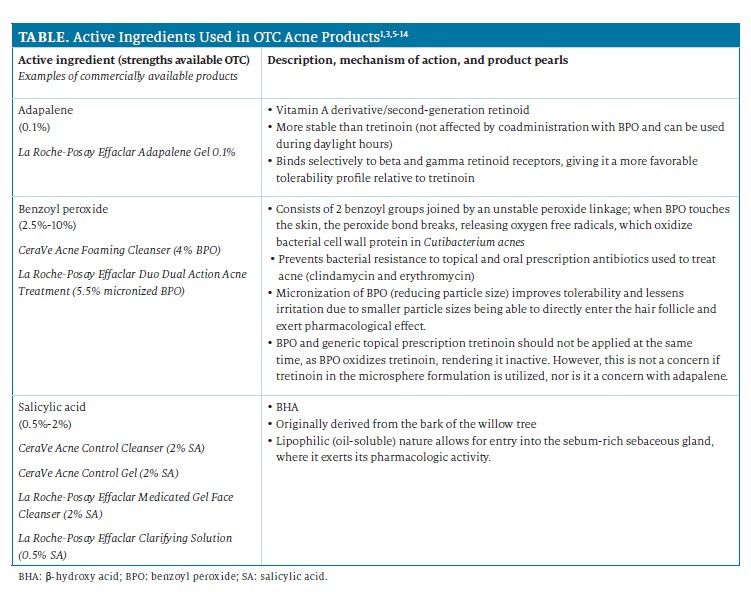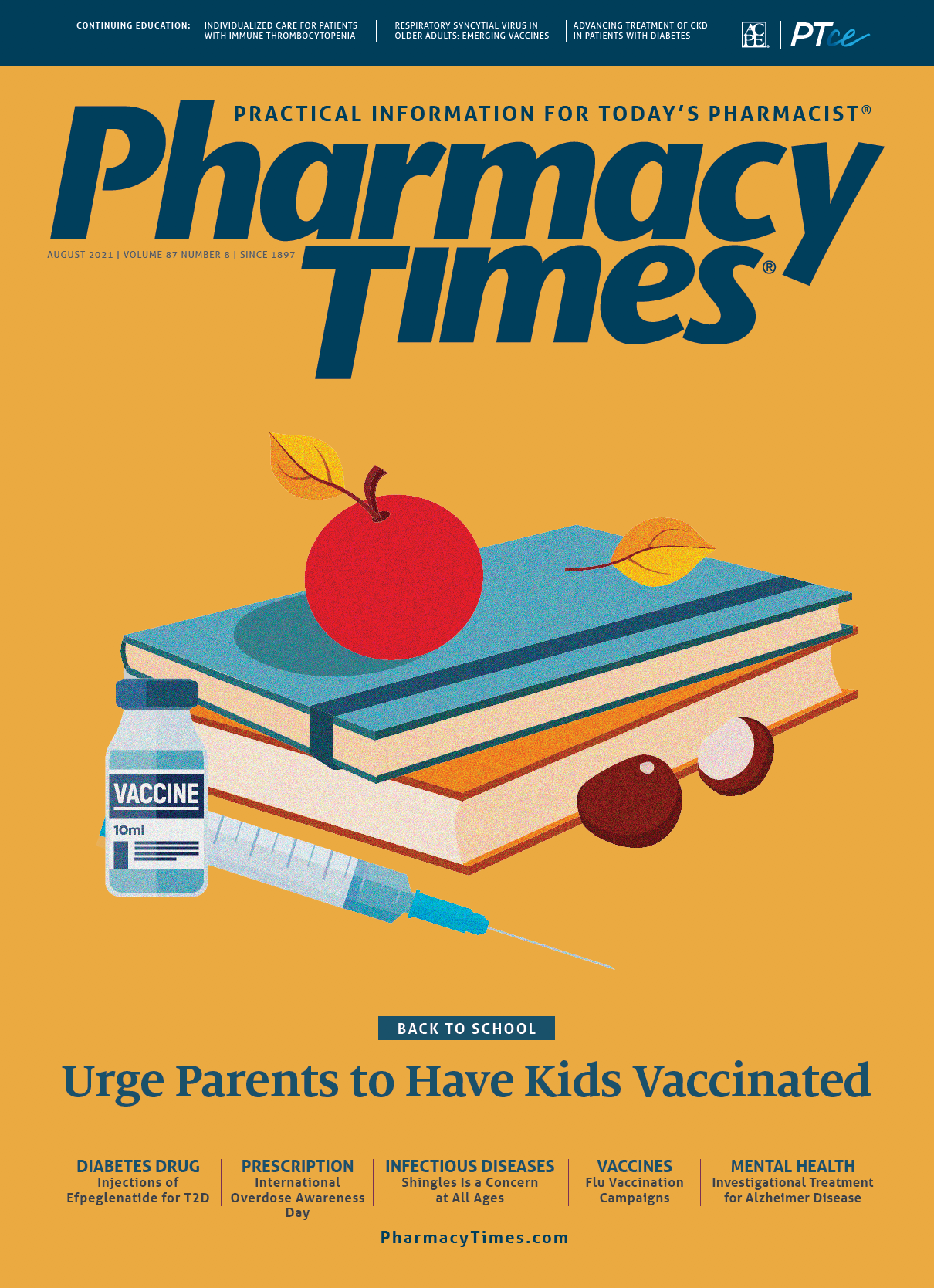Publication
Article
Pharmacy Times
Considerations for the Pharmacist in Recommending OTC Acne Products and Adjunctive Therapy With Moisturizers and Cleansers
This article was sponsored by CeraVe and La Roche-Posay.
ACNE VULGARIS
Acne vulgaris (AV) is an inflammatory condition affecting the hair follicles and sebaceous glands of the skin. It is characterized by open comedones (blackheads), closed comedones (whiteheads), papules, pustules, cysts, and/or nodules.1 AV is the most common of all skin conditions, affecting approximately 50 million adolescents, young adults, and adults in the United States.1 AV is associated with various sequelae, including permanent skin scarring, poor self-esteem, anxiety, and depression.
Although it is advisable for patients with AV to be treated under the supervision of a board-certified dermatologist, people may seek recommendations from a pharmacist on OTC products to help treat their acne. As there are a wide variety of options and brands available—such as La Roche-Posay and CeraVe, the No. 1 dermatologist-recommended moisturizer brand for acne (according to a ProVoice Survey sponsored by L’Oréal, fielded from February 1, 2020, through January 31, 2021)—a pharmacist is uniquely positioned to help people select the most appropriate product(s) that can be used either alone or alongside prescription products to improve outcomes for patients with AV.2
EVOLVING LANDSCAPE OF AVAILABLE ACNE TREATMENT STRATEGIES
Over the past decade, the FDA has expanded the list of ingredients that can be used in OTC acne products.3 Benzoyl peroxide (BPO) in strengths of up to 10% and salicylic acid (SA) in strengths of up to 2% have been permitted since 2011.4 In 2016, adapalene 0.1% gel was the first retinoid to become available without a prescription (TABLE).1,3,5-14

The American Acne and Rosacea Society, the American Academy of Pediatrics, and the American Academy of Dermatology all endorse the use of BPO and topical retinoids in the first-line setting for mild, moderate, and severe acne.1,8 Examples of OTC products containing BPO include CeraVe’s Acne Foaming Cream Cleanser (4% BPO)11 and La Roche-Posay’s Effaclar Duo Dual Action Acne Treatment (5.5% micronized BPO ).12 An example of an OTC topical retinoid is La Roche-Posay’s Effaclar Adapalene Gel 0.1% Acne Treatment.15
OTC products marketed for acne that contain SA16 include Effaclar Clarifying Solution (0.5% SA ),14 CeraVe Acne Control Cleanser (2% SA ),13 and CeraVe Acne Control Gel (2% SA ).13
THE COMPROMISED SKIN BARRIER IN AV
Patients with AV often have a compromised skin barrier, characterized by reduced total ceramides and increased transepidermal water loss.17-19 Prescription and OTC acne medications can have a drying effect, which can create or further contribute to a compromised skin barrier.17-19 A compromised skin barrier in the setting of AV can exacerbate acne lesions, contribute to poor medication adherence, and lead to suboptimal outcomes.17,18
BENEFITS OF ADJUNCTIVE PRODUCTS IN THE SETTING OF AV
OTC adjunctive cleansers, moisturizers, and other topical products can be recommended for use alongside one or more prescription acne products to help facilitate or expedite acne lesion clearance, reduce irritation/inflammation, and improve patient adherence to medication.17,18
La Roche-Posay’s Anthelios Clear Skin Oil Free Sunscreen SPF 60 is sunscreen suitable for acne-prone skin and is formulated to help absorb excess oil.20,21 Similarly, CeraVe’s AM Facial Moisturizing Lotion With Sunscreen offers SPF 30 sunscreen and does not clog pores or cause flare-ups of acne.22
BPO + Clindamycin Versus BPO as Adjunct to 0.025% Tretinoin
A 12-week, multicenter, randomized, double-blind study of 60 adult patients aged 18 to 50 with mild to moderate acne evaluated the effectiveness of 2 different topical products used as adjunctive therapy to a nightly application of generic prescription 0.025% tretinoin cream. The 2 products evaluated were a prescription product (5% BPO + 1% clindamycin) and an OTC product (5.5% micronized BPO ), which matches the formulation of La Roche-Posay’s Effaclar Duo Action Acne Treatment; patients were randomized to 1 of the 2 twice-daily treatment regimens (n = 34 and n = 26, respectively). This study was sponsored by an unrestricted educational grant from L’Oréal.3
Compared with baseline acne assessment scores, both treatment groups achieved statistically significant (P < .05) reductions in acne lesion counts (inflammatory + noninflammatory) at weeks 4, 8, and 12. Those who received the OTC regimen (BPO ) achieved a statistically significant reduction in the number of pustules (assessed clinically) at week 2 compared with baseline (P < .05). The same statistically significant reduction from baseline to week 2 was not observed in those who received the prescription product (BPO + clindamycin).3 Both treatment groups experienced statistically significant increases in dryness and peeling compared with their group’s respective baseline values at weeks 2 and 4. Those who received BPO did not experience a significant increase in erythema at week 2 compared with baseline; those in the BPO + clindamycin group did (P = .042).3
ROLE OF THE PHARMACIST
People with AV may seek a recommendation for one or more OTC products to use either alone or in combination with a prescription product. Pharmacists should ascertain if the person is already on a therapeutic regimen for AV and, if so, what products they are currently using. Adding certain OTC products to a prescription regimen could be overly irritating, further compromise the skin’s barrier,17 and/or render some prescription products inactive.
A pharmacist can provide education of appropriate adjunctive OTC options to help increase medication adherence and maximize the likelihood for acne clearance.
REFERENCES
- Zaenglein AL, Pathy AL, Schlosser BJ, et al. Guidelines of care for the management of acne vulgaris. J Am Acad Dermatol. 2016;74(5):945-73.e33. doi:10.1016/j.jaad.2015.12.037
- Draelos ZD, Shalita AR, Thiboutot D, Oresajo C, Yatskayer M, Raab S. A multicenter, double-blind study to evaluate the efficacy and safety of 2 treatments in participants with mild to moderate acne vulgaris. Cutis. 2012;89(6):287-293.
- FDA. Guidance for industry: topical acne drug products for over-the-counter human use – revision and labeling and classification of benzoyl peroxide as safe and effective. Published June 2011. Accessed April 22, 2021. https://www.fda.gov/files/drugs/published/Topical-Acne-Drug-Products-for-Over-the-Counter-Human-Use--Revision-of-Labeling-and-Classification-of-Benzoyl-Peroxide-as-Safe-and-Effective.pdf
- Tolaymat L, Zito PM. Adapalene. In: StatPearls. StatPearls Publishing; 2021. Accessed May 19, 2021. https://www.ncbi.nlm.nih.gov/books/NBK482509/
- FDA approves Differin Gel 0.1% for over-the-counter use to treat acne: first retinoid approved for over-the-counter use. News release. FDA; July 08, 2016. Accessed May 18, 2021. https://www.fda.gov/news-events/press-announcements/fda-approves-differin-gel-01-over-counter-use-treat-acne
- Baldwin H. New options in acne care: assessing OTC formulations. Pract Derm. March 2020:1.
- Eichenfield LF, Krakowski AC, Piggott C, et al. Evidence-based recommendations for the diagnosis and treatment of pediatric acne. Pediatrics. 2013;131 (suppl 3):S163-S186. doi:10.1542/peds.2013-0490B
- Zeichner JA. The use of lipohydroxy acid in skin care and acne treatment
J Clin Aesthet Dermatol. 2016;9(11):40-43. - La Roche-Posay. Effaclar Medicated Acne Face Wash. La Roche-Posay. Accessed May 18, 2021. https://www.laroche-posay.us/shop-by/view-allproduct-lines/effaclar/effaclar-medicated-acne-face-wash-883140040231.html?cgid=effaclar#start=5
- Acne Foaming Cream Cleanser. CeraVe. Accessed May 18, 2021. https://www.cerave.com/skincare/cleansers/acne-benzoyl-peroxide-cleanser
- Effaclar Acne Treatment System. La Roche-Posay. Accessed May 18, 2021. https://www.laroche-posay.us/acne-and-oily-skin-care/effaclar-acne-
treatment-system-883140035282.html - CeraVe data on file. May 2021.
- Effaclar Clarifying Solution Acne Toner. La Roche-Posay. Accessed May 18, 2021. https://www.laroche-posay.us/shop-by/view-all-product-lines/ effaclar/effaclar-clarifying-solution-acne-toner-883140040248.html?cgid=effaclar#start=7
- Effaclar Adapalene Gel 0.1% topical retinoid for acne. La Roche-Posay.Accessed May 19, 2021. https://www.laroche-posay.us/face-and-bodyskin-care/effaclar-adapalene-gel-0.1%25-topical-retinoid-for-acne-
3606000527553.html - Saint-L ger D, L v que JL, Verschoore M. The use of hydroxy acids on the skin: characteristics of C8-lipohydroxy acid. J Cosmet Dermatol. 2007;6(1):59-65. doi:10.1111/j.1473-2165.2007.00296.x
- Lain E, Andriessen AF. Choosing the right partner: complementing prescription acne medication with over-the-counter cleansers and moisturizers. J Drugs Derm. 2020; 19(11):1069-1075. doi:10.36849/JDD.2020.5536
- Lynde C, Tan J, Andriessen A, et al. A consensus on acne management focused on specific patient features. J Cutan Med Surg. 2014;18(4):243-255. doi:10.2310/7750.2013.13154
- Jordan L, Baldwin HE. Stratum corneum abnormalities and disease-affected skin: strategies for successful outcomes in inflammatory acne. J Drugs Dermatol. 2016;15(10):1170-1173.
- Acne. CeraVe. Accessed May 11, 2021. https://www.cerave.com/skin-smarts/skin-concerns/acne
- Anthelios Clear Skin Oil Free Sunscreen SPF 60. La Roche-Posay. Accessed May 18, 2021. https://www.laroche-posay.us/sunscreen/sunscreen-product-type/face-sunscreen/anthelios-clear-skin-oil-free-sunscreenspf-60-3606000430488.html
- AM Facial Moisturizing Lotion with Sunscreen. CeraVe. Accessed June 10, 2021. https://www.cerave.com/








